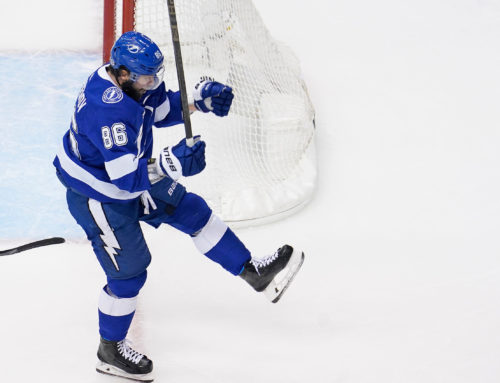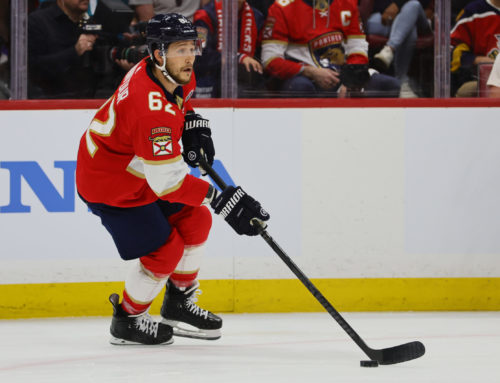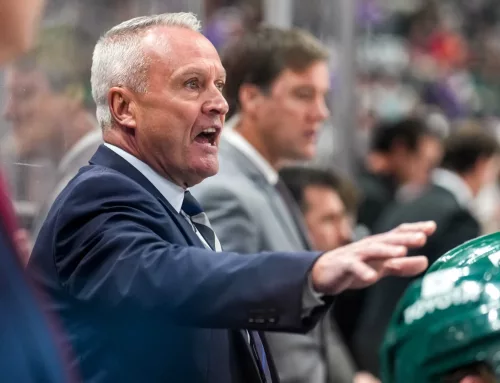Ramblings: More Defence Projections for Bouchard, Matheson, Durzi, Gavrikov, and More – September 14
Michael Clifford
2023-09-14
In Tuesday's Ramblings, we started looking at my point projections for defencemen. The focus was on groups of players, such as those leading our projections, blue liners with serious competition for top offensive time, younger stars, and others. Go read that for a review of a dozen-or-so blue liners that are comparable in some way.
Today's focus will be on individual defencemen. They will be selected because the projection gives us a big improvement/decline from recent seasons, is out of line with what I had envisioned from the outset, or for any other interesting reason. As usual, we have four caveats:
- These are the first run of projections, so there will be changes – some significant – between now and the start of the regular season.
- First-year players have not been included yet.
- We are not separating by position, so they're all defencemen and not LD/RD.
- All starting players are projected for 82 games played.
Clear as my vision at 1 AM on the second night of a bachelor party weekend? Great. Data from our Frozen Tools, Natural Stat Trick, or AllThreeZones, unless otherwise indicated.
(Note: a couple people asked me about Rasmus Dahlin's projection because he wasn't at the very top of my article on Tuesday. He is fifth among rearguards in these projections, but there's a bit of a gap between the top four and him so he was excluded.)

Seeing Edmonton's young blue liner projected for roughly 57 points was both surprising and not. His career-high is 40 points, so this would represent a sizable improvement, but he will be the top PP quarterback out of training camp and likely around 21 minutes a night. Looking into the projection, the issue is that it's giving him 80% of the top PP time, and not 95% like he finished last season with. If it does end up being closer to a 95% top PP share, his projection is likely close to 65 points. The Dobber Guide – available for purchase here! – has him at 64 points, so that seems a better bet than 57.
One thing to note about Bouchard is his blocked shots. My peripheral projections will come in the next couple weeks, but just glancing at his stats will show a big decline in blocked shots as compared to 2021-22. Overall, Bouchard's shots blocked per minute declined 27% from the year prior, and at a time when blocked shot rates are rising, any further decline will really hurt his multi-cat value.

Typical. The year after Dunn has his long-awaited breakout season, we're shaving about 20% off his outlook. Life really isn't fair.
The entire problem here is Seattle's power play, for a variety of reasons. In my offseason review, the Krakens' struggles to draw penalties was reviewed, how split their power play units and that neither of them were very good for long stretches. Dunn had 15 power play points last year and his 2023-24 projection is down a bit from that and, when combined with a bit of even-strength regression, we get the 51 points pictured above.
It wouldn't be hard to talk me into another 60-point season from Dunn. Seattle starts creating more shots to supplement their efficiency and the power play is even just a bit above average? He could do it again. The way the team runs its offence, usage-wise, is a problem and we can't project usage changes until we see usage changes.

So, this is a little worrisome. In the section on Bouchard, it was mentioned that Bouchard had seen a sizable blocked shots decline in 2022-23. Curious enough, Noah Dobson also saw a 27% decline in shots blocked per minute when compared to 2021-22, and a 17% decline in hits per minute. A guy that once seemed destined to get to the 300 hits+blocks plateau in a single season paced for just 172 hits+blocks/82 games last season.
That drop in peripherals is brought up because Dobson's point projection is right in line with his last two seasons. If he keeps producing the same rate of points, but his peripherals keep dropping, it's just bad news. He lost over a minute of ice time per game last season and if he can't get back to the 21- to 22-minute range – at least – he may not be the multi-cat monster-in-the-making he looked to be a year ago. It will be interesting to follow how the Islanders use their defencemen this season.

I had to talk about Matheson given how much he's been discussed in these pages this offseason. I thought the point projection would be higher for 82 games given how well he did in 2022-23, but the projections still don't think much of Montreal's power play – it's basically "what if Matheson ran the power play of the 2022-23 Blackhawks?". So, a better power play from the Habs will go a long way to Matheson threatening 50 points, as will a full, healthy season.
Like many other rearguards, it's the peripherals that will give Matheson his true value in multi-cat formats. Last season, had he played 75 games, he would have likely reached 40 points, 125 blocks, 80 hits, and 190 shots. He stands a reasonable chance of having a season like Justin Faulk had in 2022-23, and that's easily a top-30 defencemen in most any format. Health is paramount, but a decent power play will go a long way between good draft value and great draft value.

It shouldn't be that big of a surprise to see him paced for 40 points one season after he put up 42 points, but it would likely be a disappointment to dynasty/keeper owners if that's where he landed. In multi-cat formats, it still represents a tremendous season, but not so much in points-only formats.
The reason is obvious: Shayne Gostisbehere. After Filip Hronek was traded last season, Seider was the top PP guy with over 3 minutes of PPTOI per game while Jake Walman was closer to 1:30. The assumption for this season is that Ghost takes the Seider role and Seider takes the Walman role. At 1:30 of PPTOI per game for 82 games, Seider would have 123 minutes of total PPTOI. Last season, no defenceman with fewer than 125 minutes of PPTOI had more than 8 power-play points. Even if he had a league-leading PP points/minute rate, at that level of TOI, he wouldn't get to 20 PPPs. He will get some top PP time, but unless he's around 2 minutes/game overall, it's hard to see a production improvement, and thus we get this projection.

Ok, I have to admit, this one is probably very, very wrong. Columbus added both Ivan Provorov and Damon Severson in the offseason, have a healthy Zach Werenski, Jake Bean is presumably healthy, Andrew Peeke and Erik Gudbranson are still around, and there are a number of high-end defence prospects in the system. Despite all this, the assumption is that Boqvist will get some top PP time (about 10% of available TOI) and is on the second unit for the rest of it. Those power play projections, on top of an improved even-strength offence, give him a strong point projection.
Boqvist is an interesting player. He has typically been an excellent playmaker from the blue line and is good at creating controlled zone entries when playing off the rush. The problem is that he's an absolute horror show defensively and just being good offensively isn't enough to offset the defensive deficiencies. With Mike Babcock in town, how much leash Boqvist gets playing that style is very much in doubt. I believe in his skills, but the blue line is filling up, his coaches generally haven't put up with his defensive lapses, and he's yet to reach 19 minutes/game in any season. If he flirts with 40 points, that's great news for him and the team, but it's hard to see it happening.

It is time to talk about the Coyotes.
As I've mentioned frequently when talking about forward projections, the Coyotes power play has not been a haven for points for quite some time. The hope is that Durzi and Juuso Välimäki replacing Gostisbehere and Jakob Chychrun – two guys that love to shoot – can help with efficiency, but that's a hope and not a promise. Then there is the issue with what the PP units look like – 3F/2D or 4F/1D – and Durzi/Välimäki spelling each other off on the top unit throughout the season. For all these reasons, Durzi's projection for PP points is just shy of 11, or roughly what JJ Moser did last season. Durzi also won't get heavy even-strength minutes, and Arizona is not yet a top-end offensive team at even strength, so his projection there is basically in line with what he did in 2022-23. Put it all together and it's a 35-point season.
Looking at different projections, the Dobber Guide has him pacing for over 51 points in 82 games, Evolving Hockey has him over 41 points, and ESPN has him for over 25. Four different projections, none closer than six points apart, and spread between 25-52 points. Honestly, that range of outcomes feels appropriate. His ADP seems to fall between the 50th and 60th defenceman off the board, so at least the price is right for that gamble.
Juuso Välimäki

Now, to the other notable Arizona blue liner and a projection that isn't that far off from Durzi's.
Using the same four projection sources as Durzi, the spread is tighter: a high of 46.5 points/82 games in the Dobber Guide and a low of what I have for him. Four projections within 14 points gives us half the spread of his teammate so maybe he's a safer fantasy bet? That feels both true and misleading at the same time.
Anyway, the issue with Välimäki is the same as his partner: the power play. A non-elite power play with a rotation on the blue line and differing setups does not portend high-end power-play production. If there is any sort of clarity on the power play roles in training camp, the projections for these two players could change a lot. Again, the price to buy in drafts is relatively cheap so it's probably worth the risk, especially Durzi with his peripheral upside.

This projection represents a rebound from 2022-23 but a decline from 2021-22. That feels right given it's pretty much in line with what defence partner Matt Roy did last season with 26 points in 82 games.
What is curious is that Gavrikov's TOI outlook is playing around 21 minutes a night, which is what he did after being traded to Los Angeles. Why that's curious is that the pairing of Gavrikov/Roy was incredible over the team's final 20 games, controlling 80% of the goals and nearly 70% of the expected goals at 5-on-5. That was much better than the Doughty-Anderson pairing with 66% and 54%, respectively. That gulf widened significantly in the playoffs as well. We can't blame matchups, either, as the pairings' postseason ice time against Connor McDavid was virtually even (separated by one minute across six games). Despite this, Doughty played nearly 26 minutes a night down the stretch and over 28 minutes in the postseason. He played about 2:20-2:30 more per game at even strength than either Roy or Gavrikov and got crushed.
So, the question becomes: if those performances persist to start the 2023-24 season, do Gavrikov-Roy get more ice time? Tampa Bay realized last season that other defencemen were playing better than Victor Hedman (injury-related or not) and adjusted ice time accordingly. Does Los Angeles do the same if Doughty, in particular, struggles? It would be a big boost to Gavrikov's production upside if he can get to 23-24 minutes per outing rather than 20-21.
Connor Clifton

I wanted to include Clifton because Rasmus Dahlin's projection (mid-70s) seemed fine, and Owen Power's was discussed on Tuesday. It is basically in line with what Clifton did last year in Boston (23 points in 78 games), so it's not bad, but I thought it might be higher.
It turns out that the way Buffalo runs their defence is the problem. Last year, when they had the healthy players to do it, the Sabres basically ran a heavily-used top-4 of Dahlin/Power/Samulesson/Jokiharju and then minimal ice time for the bottom pair. All four of those guys are back, so the projections are assuming Clifton is on the bottom pair, and that means 14-15 minutes a game at even strength. He will be shut out of the power play unless their second unit is 3F/2D, or one of Dahlin/Power is hurt for an extended period. He will pick up some more minutes on the penalty kill, but it's not as if those minutes are conducive to point production. If he's skating 18:00 a night with almost no PP time, well, not projecting for 30-plus points makes sense.
Clifton has monster peripherals, so he'll always have worth in multi-cat formats. However, if he can get to 32 points rather than 24 points, it'd be a huge boost to his value in those leagues. Perhaps Buffalo changes the way they run the blue line and he can get to 19-20 minutes a game, but I'll have to see it to believe it.





 BUF
BUF N.J
N.J PHI
PHI MIN
MIN VAN
VAN FLA
FLA TOR
TOR CGY
CGY DET
DET